Category: Arts
Love (and the Giants) Conquer All
At the SoHo Playhouse this afternoon for Piaf: Love Conquers All, LVR Productions‘ one-woman show on the life of Édith Piaf, which began its Off-Broadway run on December 8. The show had been set to play downtown through late January, but due to popular demand, its run was extended by three weeks through February 10. Check out a commercial for show here.
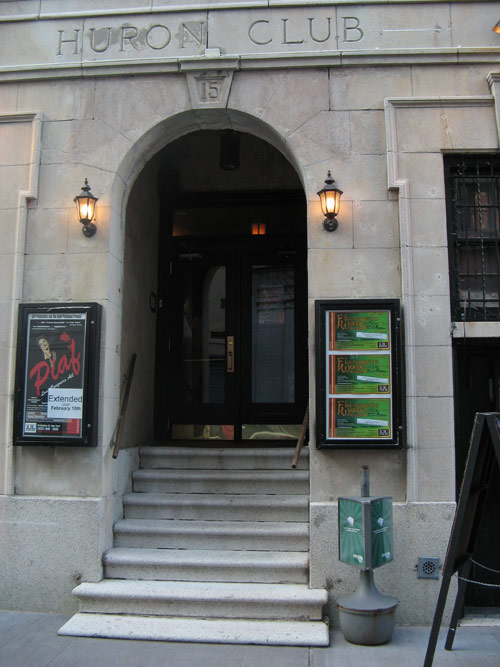
Naomi Emmerson stars in the title role (as well as also being responsible for the set and costume design and stage direction) with Carmela Sinco accompanying on the piano. Emmerson grew up one of three daughters of a Quebecois Anglophone family — the only one to speak French fluently. She first performed Piaf: Love Conquers All at The Limelight Supper Club in Toronto in 1993, re-creating the role for the 2005 Toronto Fringe Festival. The show had its American debut at last summer’s FringeNYC festival, where it won an Overall Excellence Award for Outstanding Musical. Thirteen of Piaf’s songs were interspersed among the biographical anecdotes whose plot points were familiar to me from La Vie En Rose — the Piaf biopic, which earned French actress Marion Cotillard her Oscar nomination and Golden Globe win (not that anyone noticed.)
As a revue of Piaf’s songs, the show worked well; we were admonished at the outset to resist the urge to join in singing the more familiar tunes, a temptation avoided by most in the audience. Most. I was less moved by the show as a story framed around the singer’s loves and heartbreaks. Act I (“Marcel”), set in 1949 with flashbacks, closes with the plane crash death of middleweight championship boxer Marcel Cerdan, the man generally perceived to be the love of Piaf’s life. The second, shorter half fast-forwards to 1961 and features a visibly diminished Piaf – wracked by rheumatism and addiction. Her post-Cerdan lovers for the most part don’t even warrant names — the pair of cyclists, “the artist,” “the actor” — and though this act is titled “Theo,” after Piaf’s second husband Théo Sarapo, a Greek hairdresser-turned-singer and actor two decades her junior, the man seems less a great love than the singer’s last ditch hope for love at last. As in the film, the show closes on Piaf’s defiant declaration: “Non, Je ne Regrette Rien.”
It was such a beautiful day that I decided to walk uptown. At Father Demo Square:
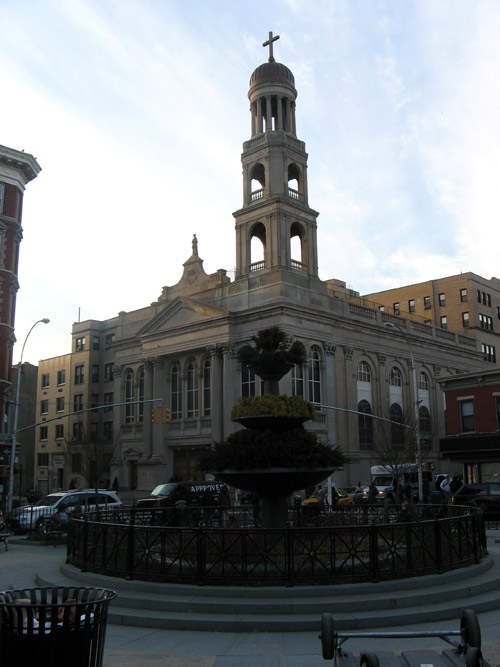

As dusk approached, the sidewalks began emptying of people as everyone gathered around the communal televisions for Super Bowl XLII. By now, we all know how that turned out, no? And after our underdog Giants quarterback hit receiver Plaxico Burress for the winning touchdown with 35 seconds left in the game, following that incredible, fortune-changing Hail Manning… well, for an otherwise “miserable city,” there was an outpouring of joy in the streets.
The Slug Bearers of Kayrol Island
The ever-versatile and accomplished Ben Katchor is the 1995 recipient of a Guggenheim Fellowship, a 2000 MacArthur Fellow, an Obie Award winner (for his “comic-book opera,” The Carbon Copy Building), and creator of books, graphic novels, cartoon strips, magazine illustrations, and radio shows. Katchor wrote the libretto and created the animated drawings for The Slug Bearers of Kayrol Island (or The Friends of Dr. Rushower), the show I was at The Vineyard Theatre to see tonight. (The same company developed the critically acclaimed Avenue Q and [title of show].) Check out the commercial for their latest show here.
Katchor described it as an “absurdist romance… about the romance of poetry and humanitarianism.” For his darkly funny, slyly political musical, he collaborated with Mark Mulcahy, former frontman for indie rockers Miracle Legion and Adventures of Pete & Pete house band Polaris. The Kitchen, New York’s non-profit experimental performance space, commissioned The Slug Bearers of Kayrol Island and secured the majority of the show’s funding; it was presented at the Massachusetts Museum of Contemporary Art in 2003 and at The Kitchen in 2004 before making its way to Union Square.
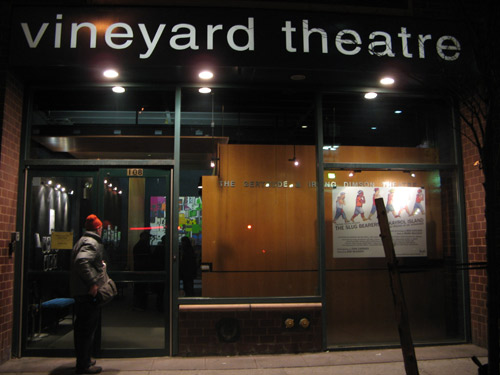
The action is set in Manhattan and on a tropical factory-island in the fictional “Roomy Archipelago,” where workers toil to transport small lead weights (destined for placement in unseen appliances to give the impression of “heft and worth”) from factory to ship. After the laborers plight is exposed on the news, well-intentioned philanthropist Dr. Rushower (Peter Friedman) takes it up as his annual cause to organize an expedition from New York City to Kayrol Island; he sends his idealistic daughter GinGin (Jody Flader) and her suitor Immanuel Lubang (Bobby Steggert) to provide solace to the exploited workers by introducing them to the beauty of “consumer fiction” — poetry found in the text of obscure appliance instructional pamphlets. Complications ensue when the locals don’t — or can’t — appreciate the offering, and GinGin falls in love with local slug bearer Samson (Matt Pearson) — who, as it happens, is not all that unhappy with his lot — drawn to the liberation of a life where labor is divorced from purpose. Katchor’s colorful, shifting landscapes are projected onto large, folding screens on stage: a swanky penthouse, a poetry slam at a Macedonian coffee house, a city street, a biplane soaring over the ocean, a tropical paradise marred by smokestacks and cinderblock buildings… The overall effect is whimsical and delightful, and Mulcahy’s catchy pop score is sung through by the actors and played with terrific energy by an actual four-piece rock band.
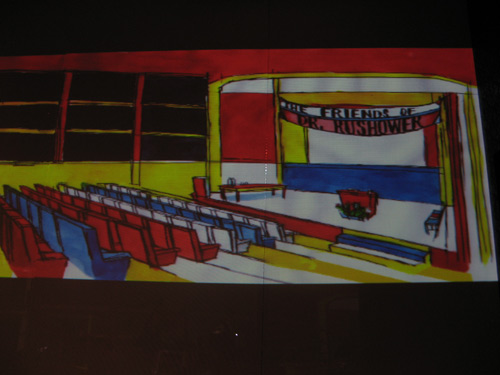
The Slug Bearers of Kayrol Island is playing at The Vineyard Theatre through March 2, 2008.
Two Thousand Years
The B brothers had procured tickets to the five hour opera marathon that is Richard Wagner’s Die Walküre at The Met — immortalized in the classic 1957 Bugs Bunny cartoon “What’s Opera, Doc?,” a.k.a., “Kill the Wabbit,” #1 of the “50 Greatest Cartoons: As Selected by 1,000 Animation Professionals” in 1994. As neither of the men thought he had the endurance to make it through the entire Lorin Maazel-helmed evening, the three of us tentatively planned on swapping out of the seats and dividing the show’s acts among ourselves — two segments apiece, which no doubt would have confused the heck out of our fellow patrons in the front balcony. Ultimately, though, the opera relay plan did not come to fruition. (I was told afterwards that based on how much they did see, it was a pretty amazing show.)
Instead, I was at The Acorn in Theatre Row for The New Group’s American premiere of Mike Leigh’s Two Thousand Years, featuring onetime troubled actress Natasha Lyonne, which began previews on January 15.
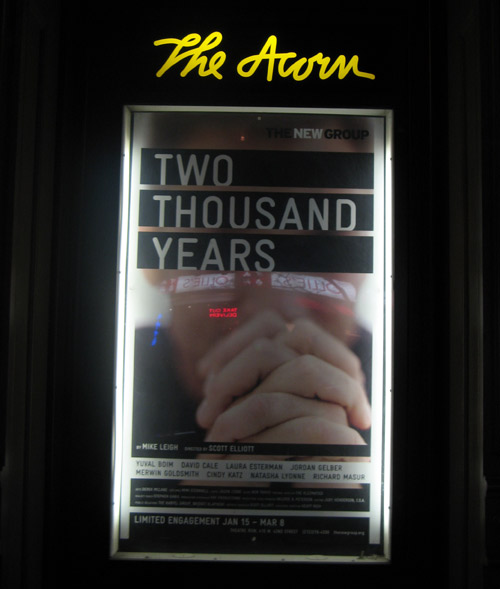
Leigh has written more than 20 plays since 1965; the four which have been staged previously by the New Group — Ecstasy, Goose Pimples, Smelling a Rat, and Abigail’s Party — all date from his late 70s and 80s residence at London’s Hampstead Theatre. For the most part, Americans — I included — are more familiar with Leigh’s film work, such as Naked (1993), Secrets and Lies (1996), Topsy-Turvy (1999) and Vera Drake (2004).
Commissioned by the National Theatre back in 2001, Two Thousand Years is the playwright’s first play in over a decade. As such, there was quite a bit of excitement in theatre circles when its imminent arrival was announced in 2003; before the play even had a title, and with no information available about its content, it managed to sell out the entire 16,000 tickets of its London run.
This is the first of Leigh’s works — film or theatre– to deal exclusively with his Jewish background. The story concerns a well-to-do, intellectual Jewish family in the Northern London suburb of Cricklewood, and the domestic trauma that ensues when their brooding, unemployed, university-educated son becomes religiously observant. The rest of the family is decidedly secular: although several members have spent time on Israeli kibbutzes, and all of them casually toss Yiddish words into conversation, they eat bacon and do not attend synagogue; their “Jewishness” seems mostly reflected by their close reading of The Guardian‘s coverage on the Gaza disengagement, bewailing the loss of their Zionist ideals, and loudly shouting during family gatherings. (That last is a stereotype that’s been reinforced endlessly on American sitcoms such as Will & Grace and Frasier. I know: I’ve watched the late night syndicated episodes more times than I care to admit.) When the son starts sporting a kippah (yarmulke) and skulking out into the patio for morning prayers, his parents are at a loss over how to react. (“It’s like having a Muslim in the house… or a martian,” balks the father; the mother, in the meantime, frets over what her son will be able to eat.) In addition, there are the usual family conflicts: sibling rivalries, an estranged aunt (who makes a sudden, unexpected appearance in the second half) and an argumentative grandfather.
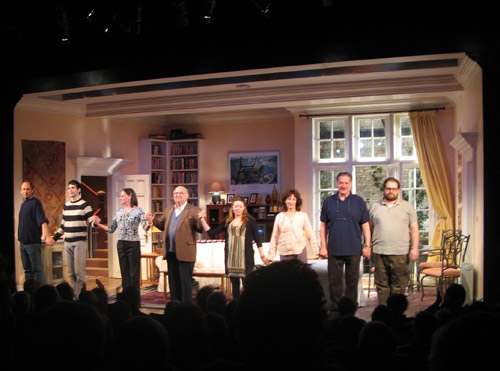
An intriguing premise and excellent acting throughout, with scene fade-ins and outs punctuated by original music by the New York-based Klezmatics. Based on the frequent outbreaks of laughter, the audience seemed to enjoy it quite a bit, while the play’s analysis of the strains of religion and family life were both thought provoking and moving.
| S | M | T | W | T | F | S |
|---|---|---|---|---|---|---|
| 1 | 2 | 3 | 4 | |||
| 5 | 6 | 7 | 8 | 9 | 10 | 11 |
| 12 | 13 | 14 | 15 | 16 | 17 | 18 |
| 19 | 20 | 21 | 22 | 23 | 24 | 25 |
| 26 | 27 | 28 | 29 | 30 | 31 | |
Search
Popular Tags
Categories
Archive
- July 2010
- July 2009
- January 2009
- November 2008
- September 2008
- August 2008
- July 2008
- June 2008
- May 2008
- April 2008
- March 2008
- February 2008
- January 2008
- December 2007
- November 2007
- October 2007
- September 2007
- August 2007
- July 2007
- June 2007
- May 2007
- April 2007
- March 2007
- February 2007
- January 2007
- December 2006
- November 2006
- October 2006
- September 2006
- August 2006
- July 2006
- June 2006